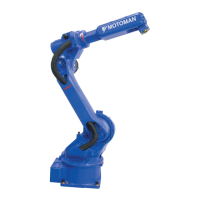3-18
168542-1CD
168542-1CD
MLX200 Software and
Operations
3 Developing with MLX200
3.3 Programming Introduction
3.3.8.1 Aborted Motions
A motion is aborted by pressing the [ABORT] button, calling the MLxAbort
instruction, pressing the [EMERGENCY STOP] on the control panel, or
opening the Guard Circuit on the control panel. When aborting, the robot
will stop immediately and servos will be disengaged. The stop is a
controlled category 1 stop (i.e. the robot is decelerated to a stop along its
path before servo power is removed).
After stopping, the system will be in the ServosOffAborted state. There are
two methods to recover from this state: pressing Reset (MLxReset) or
pressing ResetAndHold (MLxResetAndHold). If pressing Reset, any
motions left in the queue will be flushed. In this case, the program step
should be reset, so that the program can restart from the beginning. If
pressing ResetAndHold, the motions in the queue are held so that the
program can start from where it left off. In this case, the program step
should not be reset so that the same instructions are active after pressing
START again.
3.3.8.2 Stopped Motions
By pressing the [Stop] button on the HMI or by calling the MLxStop
instruction, the robot will come to a Control Module stop but stay in the Idle
state (i.e. servos will still be enabled). This can be used to stop the robot's
current action and command it to do some other task. It is again up to the
application developer to make sure the program step is correct during this
operation.
The ABORT functionality provided in the MLX-HMI and the MLxAbort
instruction should not be used for emergency stopping of the robot. The
[EMERGENCY STOP] button that is hardwired in to the control panel
should be used for this purpose and for any safety related interlocks.
It is up to the application developer to handle the program
step correctly when restarting the application depending on
the use of Reset or ResetAndHold.
In this case that a motion is stopped while the robot is
currently blending between two motions, the robot will stop
along its current tangent direction. After restarting, it will
move to its next commanded point but will not follow the
exact path it would have if it had not been stopped.

